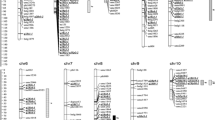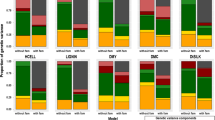Summary
It has been suggested that molecular foundations of phenotypic diversity reside in the variability of genome expression. This variability can be appraised through the polymorphism of individual protein amounts (PAP: protein amount polymorphism). Eight maize inbred lines and ten of their single-cross hybrids were analyzed by two-dimensional polyacrylamide gel electrophoresis in order to examine the potential of PAP for predicting hybrid vigor. The 28 possible pairs of lines were characterized for: (i) the number, H of expected heterozygous structural loci in their hybrid, in the sample of loci revealed by 2D-PAGE; (ii) four distance indices based on PAP; (iii) the hybrid values for five agromorphological characters measured in four different year/locations. For the subset of ten hybrids analyzed by 2D-PAGE, the number of cases of nonadditive inheritance (NA) was also counted. Whereas H appeared to be related neither to the PAP indices, nor to NA, nor to hybrid performances, PAP indices were correlated to NA, and both were positively associated to hybrid performances. The possibility that PAP is responsible for quantitative trait variation is discussed. This could result in the definition of biological predictors of heterosis.
Similar content being viewed by others
References
Atchley WR (1989) Introduction to the symposium “Evolution of developmental systems. ” Am Nat 134:437–512
Bahrman N, Damerval C (1989) Linkage relationships of loci controlling protein amounts in maritime pine (Pinus pinaster Ait). Heredity 63:267–274
Bahrman N, Vienne D de, Thiellement H, Hofmann JP (1985) Two-dimensional gel electrophoresis of proteins for genetic studies in Douglas Fir (Pseudotsuga menziesii). Biochem Genet 23:247–255
Charcosset A, Lefort-Buson M, Gallais A (1990) Use of top- cross designs for predicting performance of maize single- cross hybrids. Maydica 35:23–27
Charcosset A, Lefort-Buson M, Gallais A (1991) Relationship between heterosis and heterozygosity at marker loci: a theo- retical computation. Theor Appl Genet 81:571–575
Damerval C, Vienne D de, Zivy M, Thiellement H (1986) Technical improvements in two-dimensional electrophoresis increase the level of genetic variation detected in wheat- seedling proteins. Electrophoresis 7:52–54
Damerval C, Hébert Y, Vienne D de (1987 a) Is the polymor- phism of protein amounts related to phenotypic variability ? A comparison of two-dimensional electrophoresis data with morphological traits in maize. Theor Appl Genet 74:194–202
Damerval C, Le Guilloux M, Blaisonneau J, Vienne D de (1987b) A simplification of Heukeshoven and Dernick's silver staining of proteins. Electrophoresis 8:158–159
Frei OM, Stuber CW, Goodman MM (1986) Use of allozymes as genetic markers for predicting performance in maize single cross hybrids. Crop Sci 26:37–42
Ghaderi A, Adams MW, Nassib AM (1984) Relationship be- tween genetic distance and heterosis for yield and morpho- logical traits in dry edible bean and faba bean. Crop Sci 24:37–42
Godshalk EB, Lee M, Lamkey KR (1990) Relationship of re- striction fragment length polymorphisms to single-cross hy- brid performance of maize. Theor Appl Genet 80:273–280
Gottlieb LD, Vienne D de (1988) Assessment of pleiotropic ef- fects of a gene substitution in pea by two-dimensional poly- acrylamide gel electrophoresis. Genetics 119:705–710
Gower JC (1966) Some distance properties of latent root and vector methods used in multivariate analysis. Biometrica 53:325–338
Granier F, Vienne D de (1986) Silver staining of proteins: stan- dardized procedure for two-dimensional gels bound to poly- ester sheets. Anal Biochem 155:45–50
Klose J (1982) Genetic variability of soluble proteins studied by two-dimensional electrophoresis on different inbred mouse strains and on different mouse organs. J Mol Evol 18:315–328
Lee M, Godshalk EB, Lamkey KR, Woodman WW (1989) Asso- ciation of restriction fragment length polymorphism among maize inbreds with agronomic performance of their crosses. Crop Sci 29:1067–1071
Leonardi A (1989) Variabilité et hérédité des quantités de protéines chez le maïs: analyse par électrophorèse bidimen- sionnelle et relations avec la variabilité agromorphologique. PhD thesis, University of Paris VII, 166 pp
Leonardi A, Damerval C, Vienne D de (1987) Inheritance of protein amounts: comparison of two-dimensional electro- phoresis patterns of leaf sheath of two maize lines (Zea mays L.) and their hybrids. Genet Res 50:1–5
Leonardi A, Damerval C, Vienne D de (1988) Organ-specific variability and inheritance of maize proteins revealed by two-dimensional electrophoresis. Genet Res 52:97–103
Marchais L (1978) Une analyse génétique chez le petit mil péni- cilliaire à l'aide de la distance R de Hanson et Casas. Ann Amel Plant 28:165–193
Melchinger AE, Lee M (1990) Use of RFLPs for investigating relationships among inbreds and predicting heterosis in maize. In: Proc 15th Congress of Eucarpia, June 4–8, 1990, Baden, Austria
Murray M, Cramer J, Ma Y, West D, Romero-Severson J, Pitas J, DeMars S, Vilbrandt L, Kirshman J, McLeester R, Schilz J, Lotzer J (1988) Agrigenetics maize RFLP linkage map. Maize Genet Coop Lett 62:89–91
O'Farrell P (1975) High resolution two-dimensional electro- phoresis of proteins. J Biol Chem 250:4007–4021
Rosenblum BB, Neel JV, Hanash SM (1983) Two-dimensional electrophoresis of plasma polypeptides reveals “high” het- erozygosity indices. Proc Natl Acad Sci USA 80:5002–5006
Scopes RK (1974) Measurement of protein by spectrophotome- try at 205 nm. Anal Biochem 59:277–282
Seguin M (1990) Etude de l'hétérozygotie chez le blé tendre par électrophorèse bidimensionnelle des protéines totales et relation avec des caracteres agronomiques. PhD thesis, University of Paris-Sud, 211 pp
Shifriss C, Sacks JM (1980) The effect of distance between par- ents on the yield of sweet pepper × hot pepper hybrids, Cap- sicum annuum L., in a single harvest. Theor Appl Genet 58:253–256
Siddiqui IA, Prasad RC, Mehrar B (1976) Hybrid performance in relation to genetic divergence in some varieties of Gossyp- ium hirsutum. Z Pflanzenzuecht 77:215–221
Smith JSC, Smith OS (1989 a) The description and assessment of distance between inbred lines of maize. I. The use of morpho- logical traits as descriptors. Maydica 34:141–150
Smith JSC, Smith OS (1989b) The use of morphological, bio-chemical, and genetic characteristics to measure distance and to test for minimum distance between inbred lines of maize (Zea mays L.). In: Proc UPOV Workshop, Versailles, October 1989
Vienne D de, Leonardi A, Damerval C (1988) Genetic aspects of variation of protein amounts in maize and pea. Electrophoresis 88 11:742–750
Zivy M, Thiellement H, Vienne D de, Hofmann JP (1983) Study on nuclear and cytoplasmic genome expression in wheat by two-dimensional gel electrophoresis. 1. First results on 18 alloplasmic lines. Theor Appl Genet 66:1–7
Zivy M, Thiellement H, Vienne D de, Hofmann JP (1984) Study on nuclear and cytoplasmic genome expression in wheat by two-dimensional gel electrophoresis. 2. Genetic differences between two lines and two groups of cytoplasms at five developmental stages or organs. Theor Appl Genet 68:335–345
Zivy M, Devaux P, Blaisonneau J, Jean R, Thiellement H (1991) Segregation distorsion and genetic linkage studies in mi- crospore derived doubled haploid lines of Hordeum vulgare L. Theor Appl Genet (in press)
Author information
Authors and Affiliations
Additional information
Communicated by P. L. Pfahler
Rights and permissions
About this article
Cite this article
Leonardi, A., Damerval, C., Hébert, Y. et al. Association of protein amount polymorphism (PAP) among maize lines with performances of their hybrids. Theoret. Appl. Genetics 82, 552–560 (1991). https://doi.org/10.1007/BF00226790
Received:
Accepted:
Issue Date:
DOI: https://doi.org/10.1007/BF00226790




